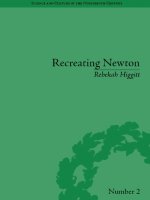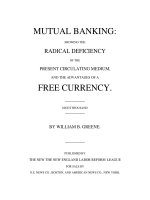Marketing death culture and the making of a life insurance market in china
Bạn đang xem bản rút gọn của tài liệu. Xem và tải ngay bản đầy đủ của tài liệu tại đây (2.68 MB, 303 trang )
Marketing Death
This page intentionally left blank
MARKETING DEATH
Culture and the Making of a Life
Insurance Market in China
CHERIS SHUN- CHING CHAN
Oxford University Press, Inc., publishes works that further
Oxford University’s objective of excellence
in research, scholarship, and education.
Oxford New York
Auckland Cape Town Dar es Salaam Hong Kong Karachi
Kuala Lumpur Madrid Melbourne Mexico City Nairobi
New Delhi Shanghai Taipei Toronto
With offices in
Argentina Austria Brazil Chile Czech Republic France Greece
Guatemala Hungary Italy Japan Poland Portugal Singapore
South Korea Switzerland Thailand Turkey Ukraine Vietnam
Copyright © 2012 by Oxford University Press, Inc.
Published by Oxford University Press, Inc.
198 Madison Avenue, New York, New York 10016
www.oup.com
Oxford is a registered trademark of Oxford University Press
All rights reserved. No part of this publication may be reproduced,
stored in a retrieval system, or transmitted, in any form or by any means,
electronic, mechanical, photocopying, recording, or otherwise,
without the prior permission of Oxford University Press.
Library of Congress Cataloging-in-Publication Data
Chan, Cheris Shun-ching.
Marketing death : culture and the making of a life insurance market in China / Cheris Shun-ching Chan.
p. cm.
Includes bibliographical references and index.
Summary: “Marketing Death is the first book to offer a penetrating sociological analysis of the emergence of
a life insurance market outside of the Euro-American context. Drawing on rich ethnographic data, it documents
the processes and micro-politics through which local cultures shape the way a market is formed and, hence, sheds
light on the dynamics through which modern capitalist enterprises are diffused to regions with different cultural
traditions.”—Publisher’s description.
ISBN 978-0-19-539407-8 (cloth : alk. paper) 1. Life insurance—Social aspects—China. I. Title.
HG9169.C48 2011
368.3200951—dc23
2011018554
1 3 5 7 9 8 6 4 2
Printed in the United States of America
on acid-free paper
To my mother
Cheng Suet King
This page intentionally left blank
Contents
Acknowledgments
ix
Illustrations
xv
Introduction
3
1. Is China an Inviting Place for Life Insurance?
Societal Conditions, the Market, and Remaining Puzzles
19
2. Defining Life Insurance and Product Development:
Divergent Institutional Logics
51
3. Manufacturing Sales Agents: Cultural Capital
and Management Strategies
76
4. Making Transactions: Selling Strategies and Sales Discourses
115
5. Buying Life Insurance : Multiple Motives but Consistent Preferences
143
6. How Culture Matters: Culture, Market, and Globalization
169
Appendix A : Methods
195
Appendix B: Life Insurance Companies in China: 2009
227
Notes
231
Glossary
245
Bibliography
247
Index
267
This page intentionally left blank
Acknowledgments
have long been surprising to friends and colleagues
alike. When friends and colleagues outside the circle of sociology first heard that
my area of research was insurance, their common response was, “What has sociology got to do with insurance?” And when sociology colleagues learned that my
earlier work was on religion, they were also quite surprised by the disjunctive shift
in my research areas. Fortunately, it did not require much effort to convince my
colleagues of the connection between my earlier work and my current project; all
it took was a brief elaboration on my theoretical interest in the role of culture in
making a life insurance market. The idea of researching the emergence of life
insurance in China was first inspired by Arjun Appadurai, who probably did not
imagine that his 15-minute meeting with me would propel me into this project
for 10 years now. In our conversations about culture and modernity, Appadurai
found the commensuration of the value of human life to a probabilistic calculation of risks sociologically intriguing. Although the ultimate outcome of my
project is not entirely about the commensurate logic of life insurance and modernity, I thank him for his stimulating conversation that triggered this project in
the first place.
My deepest gratitude goes to my informants that, unfortunately, I cannot
name individually here. They include the sales agents, in-house managers and
assistants, and life insurance clients and prospects. I am especially grateful to the
sales agents, who shared their invaluable time with me when they could have been
prospecting clients and for their unreserved openness to me and trust in my
research. I warmly thank those friends who connected me to the field. Cao Yang,
Chen Xiangming, Fan Lizhu, James Farrer, He Min, Jane Hu, Hu Jun, Charlie
Lu, Tracy Shu, Sun Han, Sun Jiaming, Sun Jiwei, Tang Nie, To Yushan, Wang
Jiangguo, Wang Lihua, Calvin Wong, Wu Yuxiao, Terry Xu, George Yang, Yap
Chong Huat, Terence Yip, Yu Hai, Yu Zhiyuan, Zhang Ji, and Zhao Dingxin all
connected me to my informants in China. My field research would have been
impossible without their help. In particular, I would like to acknowledge Zhiyuan’s
MY RESEARCH INTERESTS
x
Acknowledgments
parents, Yu Min and Zhao Qi, for their hospitality and assistance in my settling
in Shanghai, as well as Terence Yip and his colleague Ronald Wan, who worked
in the life insurance industry in Shanghai, for their help and patience with my
endless questions.
This book derives from my doctoral research. I was fortunate to work with
superb faculty during graduate school. I owe a tremendous debt of gratitude to
Gary Alan Fine, the chair of my dissertation committee, for his unfailing support
and encouragement throughout the ups and downs of my six-year-long stay at
Northwestern University. Gary and I were initially connected by our commitment to ethnography and cultural sociology. But I must admit that I was a bit
worried in the beginning that my theoretical position might not fit exactly with
his tradition. Luckily, I soon realized how open and appreciative Gary is to different theoretical positions. For this, and for his unreserved confidence in my work,
I am extremely grateful. Gary has been a good friend, and his generosity as my
mentor continued even after I left Northwestern University.
I also owe great thanks to the members of my dissertation committee: Wendy
Griswold, who followed my project from the very beginning and guided me to
locate my position in cultural sociology; Bruce Carruthers, who offered his
expertise in economic sociology that helpfully shaped my theoretical formulation; and Bobai Li, whose sharp and critical comments pushed me to make
improvements along the way. I express special thanks to Charles Ragin for launching research funding for the Center for International and Comparative Studies
(CICS) at Northwestern University, which made my first stage of research possible. I am also indebted to Charles’s engagement in my project early on and his
continuous support to me and my project after his departure from Northwestern.
My gratitude extends to my teachers and the peers who gave me feedback,
comments, and suggestions at different stages of my research. Chen Xiangming,
Matthew Chew, Lee Ching Kwan, Liu Xin, Hermann Maiba, Geeta Patel, Alvin
So, Arthur Stinchcome, Yeh Wen-hsin, Viviana Zelizer, Zhang Xiaodan, and
Zhao Dingxin—all gave me constructive comments and suggestions in the proposal stage. Participants and organizers of the Culture and Society Workshop,
Ethnography Workshop, and CICS Graduate Students Workshop at Northwestern University and the East Asia Workshop at the University Chicago deserve my
thanks for their useful feedback during my dissertation writing. Friends and colleagues who read part of my manuscript in different occasions and gave me constructive feedback include Michael Adorjan, Tom Baker, Peer Fiss, Debbie
Gould, Ho Sik Ying, Jin Lei, Erin Leddon, Assata Richards, Hovann Simonian,
Colin Smith, Ling Tang, Tao Lin, Wang Danling, Viviana Zelizer, participants of
Cultural Transformation in a Global Age Forum at the Department of Sociology,
University of Pittsburgh, participants in various seminars and workshops at
Acknowledgments
xi
UCLA (including the Global Seminar and the Center for Chinese Studies Seminar at the International Institute, and the Seminar on Theory and Research in
Comparative Social Analysis, the Culture Working Group and the Ethnography
Working Group in the Department of Sociology), and participants in the Culture Workshop at the Sociology Department of UC San Diego. I am indebted to
all these people for sharing their brilliant minds with me.
Parts of the manuscript were presented at various institutions and conferences, including the Asian Studies Center at the University of Pittsburgh; the
Departments of Sociology at Boston University, the Chinese University of Hong
Kong, and Taiwan National University; the School of Sociology and Anthropology at Sun Yat Sen University; the Department of Anthropology at the Chinese
University of Hong Kong; the Centre of Asian Studies at the University of Hong
Kong; the Half-Day Forum with the University of Sydney at the University of
Hong Kong; the annual meeting of the Association for Asian Studies in New
York (2003); the Globalization Conference at the University of Chicago (2004);
the Interim Conference on Values and Beliefs held by International Sociological
Association Research Committee on Sociological Theory in Rio de Janeiro
(2004); the World Congress of the International Institute of Sociology in Stockholm (2005); the annual meeting of the American Sociological Association in
Atlanta (2003) and in Montreal (2006). I was fortunate to have numerous engaging audiences who often raised sharp, thoughtful, challenging, and constructive
questions to push me to ponder and refine my arguments. I also had the privilege
of participating in the Summer Institute on “Economy and Society: Trajectories
of Capitalism,” held by Neil Fligstein and Walter Powell at the Center for
Advanced Study in the Behavioral Sciences in the summer of 2006, where I benefited from exchanging ideas with a group of superlative young scholars.
My year-long ethnography in China would not have been possible without
funding support from the International Dissertation Field Research Fellowship
offered by the Social Science Research Council, the research grants by the CICS
and the Graduate School at Northwestern University, and the Scholarship Development Award by the Midwest Sociological Society. The Alumnae Dissertation
Fellowship offered by Northwestern University freed me from teaching and
made my dissertation writing more efficient. The University Center for International Studies, Asian Studies Center, and China Council at the University of
Pittsburgh all provided financial support for my follow-up fieldwork in 2004.
The Center for Asian Studies at the University of Hong Kong kindly hosted me
during my writing in Hong Kong. The International Institute at the University of
California, Los Angeles generously extended a fellowship for completing the
manuscript. I am grateful to these funding institutions not only for their financial
contributions but also for their recognition of the significance of this project.
xii
Acknowledgments
I thank the team at Oxford University Press for their great efforts in moving
this book along. James Cook, the editor of this volume, deserves special thanks
for his appreciation of the manuscript early on and his enthusiasm in making this
book as perfect as it can be (though it is still far from perfect). While some editors from other publishers complained about the difficulties of securing reviewers
for my manuscript, James incredibly convinced seven highly engaging reviewers
to read through the entire manuscript at two different points of time. I have
undoubtedly benefited from these anonymous reviewers’ insightful comments
and constructive suggestions. I thank each of them for their critical eye and generous feedback that improves this book in many ways, particularly Viviana
Zelizer, who decided to reveal herself as one of the reviewers, and offered enthusiastic encouragement and specific comments to sharpen this book. My thanks
also extends to James Cook and Joe Jackson for their patience in working with me
for the cover, and to Jenny Wolkowicki and Lora Friedenthal for their hard work
at coordinating the production process. I thank Helen Chen, Maurice Choi,
Owen Fung, Elaine Lau, Nichole Lu, and Sherese Tong for their research assistance in some rather tedious but indispensable tasks.
It was in 2000 when I commenced this project. The journey over the years
would have been impossible without love and support from friends and family. I
thank all my dear friends in Chicago, Pittsburgh, Los Angeles, and Hong Kong
for their joyful companionship and enduring friendship, particularly Yenni,
Wing, Fabian, Alice, Moonlight, Sik Ying, Kaire, Mei Sin, Wong Tao, and Ming
Ming. For Lucy and Anna, apart from keeping me companies through my graduate studies, I thank them for cheering me up and pulled me through some very
difficult moments in Chicago. Eng, a special friend with a passionate heart,
accompanied me through my transition from Chicago to Pittsburgh and offered
tremendous practical help that made my life so much easier. His heartily generosity will never be forgotten. My colleagues at the University of Pittsburgh, including Nicole Constable, Evelyn Rawski, Tom Rawski, Tang Wenfang, and Bell
Yung, treated me like a family member and offered unflagging support throughout my stay in Pittsburgh. I wish to express my gratitude to them from the bottom of my heart. The main body of this book was written when I resided in Los
Angeles. Ken, despite being thousands miles away, was always at my side spiritually and affectionately. His love and enthusiasm suffused me with energy and
inspiration. His enormous patience and enthusiastic encouragement embraced
and indulged me to venture to take risk for possibly most rewarding returns. I am
deeply grateful to him for sharing all the joys and pains throughout this process.
I am also lucky to have four loving siblings, who have always been supportive of
me in so many ways over the years. Finally, my dear mother and great friend,
Cheng Suet King, contributed to this book in a special way. Her eagerness to
Acknowledgments
xiii
pursue knowledge, despite the nearly insurmountable odds present in China in
the 1950s and 1960s, was passed on to her children, who have had the privilege to
pursue knowledge in a much more conducive environment. Her endurance, her
stubbornness in upholding principles, and her boundless love for her family have
nurtured us to be who we are. This book is dedicated to her.
This page intentionally left blank
Illustrations
Figures
1
2
1.1
1.2
1.3
1.4
2.1
3.1
6.1
Total Insurance Premium and Life Insurance
Premium Income in China, 1984–2004
Life Insurance Penetration in China and Shanghai
Compared to the United States, 1991–2004
Real Growth Rate of Life Insurance Premium Income in
China and Shanghai, 1994–2004
Life Insurance Growth in Relation to GDP and Per Capita
Disposable Income Growth in Shanghai, 1994–2004
Insurers’ Market Shares of the Individual Life Insurance
Business in Shanghai, 1997–2004
Estimated Numbers of Personal Accident and
Investment Policies Sold in Shanghai, 2001–2004
Insurers’ Market Shares of the Life Insurance Business
in Shanghai, 1994–2004
Sources of Top Managers’ Cultural Capital
and Its Impacts on Management Strategies
Interactive Multiple-Process Model of Culture
in Market Formation
5
6
45
46
48
49
62
113
172
Tables
3.1
5.1
5.2
5.3
Summary of Differences among Insurers Studied
Perceived Functions of Life Insurance
by Clients and Prospects
Perceived Functions of Life Insurance
by Socioeconomic Status
Types of Life Insurance Policies Purchased
as Reported by 128 Clients
83–84
158
159–160
161
xvi
Illustrations
A.1
A.2
A.3
Summary of Fieldwork, 2000–2004
Summary of the Socioeconomic Profiles of the
Insurance Practitioners Interviewed (N=143)
Summary of the Socioeconomic Profiles of the
Clients and Prospects Interviewed (N=131)
203
204
204–205
Marketing Death
This page intentionally left blank
Introduction
To dramatize their impact, life insurance publications did not hesitate in using death as
their “solicitor,” invoking the brevity of life to hesitant customers. . . . [Life insurance
agents] were a visible reminder of the “gloomy and disagreeable prospective” of death.
—VIVIANA
Z E L I Z E R,
Morals and Markets, 1979
For many Victorians, their first taste of life insurance appeared as an invitation to imagine,
like Scrooge in A Christmas Carol, the haunting spectre of their future mortality. Salesmen
combined plaintive scenes of the uninsured’s deathbed with sensational threats of
premature death, which in their foretelling invariably struck without warning.
—TIMOTHY
ALBORN,
Regulated Lives, 2009
If you died suddenly, would your spouse have enough money to cover your funeral costs? . . . .
If you died tomorrow, would your spouse have the financial wherewithal to provide your
children with the opportunities you always dreamed they’d have? . . . [I]f you died today . . . [w]
ould your spouse have to make drastic lifestyle adjustments to make ends meet? . . . If someone
would suffer financially upon your death, you need life insurance.
— A D V E R T I S E M E N T , Time, September 2006
We can’t talk about death, you know, it’s a taboo. . . . [The Chinese] don’t want to hear
about misfortunes. They don’t want to think about those things. They don’t want to talk
about those things. It’s very difficult!
—LIFE
INSURANCE SALES AGENT IN SHANGHAI,
2002
commercial life insurers have aggressively expanded
their business to Asia, Latin America, and Central-Eastern Europe as markets in
Western Europe and North America began to saturate. Home to one-fifth of the
world’s population and noted for its impressive economic growth, China has
become a primary target for this global expansion. Dozens of transnational life
insurance corporations had established offices in Beijing by the end of the 1980s,
impatiently awaiting their operating licenses. On September 25, 1992, American
International Assurance Company, Ltd. (AIA), a subsidiary of American International Group, Inc., was the first among its competitors to obtain a license to operate in Shanghai, gaining the first toehold in the People’s Republic of China. A
SINCE THE MID-1980S,
4
MARKETING DEATH
number of foreign life insurance corporations were subsequently granted licenses,
operating as joint ventures with domestic partners. By the late 1990s, locally established life insurance firms began to appear on the scene as well. Yet despite the arrival
of all of these players, creating a market for life insurance was not, and has never
been, a simple process.
In China, the local public’s resistance to the concept of life insurance was evident at the start. In the mid-1990s, one could see shopkeepers and offices in
Shanghai post signs in their windows and doors that said, “Life insurance salespeople are not welcome!”1 In 1998, Richard Huber, then chairman and CEO of
the Hartford, Connecticut–based Aetna Insurance Company, commented that a
bigger obstacle to the life insurance business than China’s bureaucracy was its
culture, specifically, that its population had “very little concept of insurance.”2
During an interview in 2000, the general manager of the Sino-German joint venture Allianz-Dazhong Life Insurance Company, Ltd. (Allianz-Dazhong) complained that the Chinese still held, in his words, “a stupid superstitious belief ”
that the topic of death should be avoided at all costs. Throughout my field
research from 2000 to 2004, Chinese life insurance sales agents were frustrated
that people “didn’t want to talk about death or hear about misfortunes.” While
advertisements in the United States give meaning to life insurance by defining it
as “a plan for if,”3 this if is “unthinkable” for the Chinese.
Intriguingly, despite the cultural taboo on death and insurance practitioners’
complaints about the difficulty of disseminating the idea of life insurance, the
life insurance business in China has been growing rapidly since the mid-1990s.
The average annual real growth of life insurance premium income from 1995 to
2004 reached 30.7 percent, compared to only 9.1 percent growth for property
insurance.4 Moreover, the proportion of revenue coming from life insurance
sales compared to revenue generated by the entire insurance industry soared
from 34 percent in 1995 to 75 percent in 2004.5 Although life insurance penetration, or its proportion of the nation’s gross domestic product (GDP), was
relatively low compared to developed markets, it did increase from 0.34 percent
to 2.02 percent during the same period. This time frame witnessed a comparable
dramatic growth in Shanghai, where average annual real growth attained 33.6
percent and penetration jumped from 0.68 percent to 2.87 percent. This impressive growth of the Chinese life insurance market starting in the mid-1990s is
vividly displayed in figures 1 and 2. Yet the puzzle remains: How could a life
insurance market grow so rapidly when death and fatal misfortunes are taboo
subjects?
This book documents the processes, the dynamics, and the micropolitics
through which a Chinese life insurance market emerged in the presence of
cultural barriers. It examines how life insurance develops in a society where
Introduction
5
the cultural setting is substantially different from the places in which it originated and where cultural values are largely incompatible with the probabilistic
logic of life insurance. This case study is intended to address a more general
question about the role of culture in economic practice and the role of local
cultures in the global diffusion of capitalist enterprises. Specifically, how can a
particular market emerge in the face of local cultural barriers? How do local
cultures shape the way a market is formed? To what extent and in what way do
local cultures wield the power to selectively adopt and reject certain modern
capitalist ideas and practices?
The Puzzle: Marketing Death When Death Is Taboo
The global expansion of the insurance industry coincided nicely with China’s
dramatic economic and institutional restructuring. Launched in 1979, Deng
Xiaoping’s daring economic reforms spurred stunning economic growth, escalating purchasing power of the Chinese people and the birth of a new middle class.
These changes created the necessary economic conditions for commercial life
insurance to emerge. At the same time, an obvious process of metropolitanization took place, with the number and size of large metropolitan areas developing
Premium
income
(billion yuan)
500
450
Life Premium Income
400
Total Premium Income
350
300
250
200
150
100
50
0
84
19
86
19
88
19
90
19
92
19
94
19
96
19
98
19
00
20
02
20
04
Year
20
Figure 1 Total Insurance Premium and Life Insurance Premium Income in China,
1984–2004
Sources: Wang, Fei, and Li (2003) for data from 1984 to 1996 and Almanac of China’s Insurance
1998–2005 for data from 1997 to 2004.
6
MARKETING DEATH
Figure 2 Life Insurance Penetration in China and Shanghai Compared to the United
States, 1991–2004
Sources: Author’s calculations based on the following data: (1) Wang et al. (2003) for life premium income in China from 1991 to 1996; (2) the marketing and research department of Haier
New York Life Insurance Company, Ltd. in Shanghai for life premium income in Shanghai from
1991 to 1996; (3) Almanac of China’s Insurance 1998–2005 for life premium income in China
and Shanghai from 1997 to 2004; (4) China Statistical Yearbook 2005 for China’s GDP; (5)
Shanghai Statistical Yearbook 2005 for Shanghai’s GDP; (7) Life Insurers Fact Book 2009 for life
premium income in the United States; and (8) the Bureau of Economic Analysis of the U.S.
Department of Commence for U.S. GDP.
rapidly (Yan, Fia, Li, and Weng 2002). The institutional and sociocultural
changes associated with the shift from communal to metropolitan cities have
largely followed Georg Simmel’s ([1903] 1971, 1950) description of the rise of
new modern life. Rapid urbanization, progressive privatization of enterprises,
contractualization of labor relations, shrinking provision of state welfare, and
reduced family sizes have exposed the urban population to various social and
economic risks. Together with the Chinese government’s welcoming and supportive attitude toward the development of commercial insurance, the institutional environment in China in the early 1990s was propitious for the emergence
of a life insurance market.
The cultural context, at first glance, was similarly promising. Urban China’s
openness to foreign cultural influences, ranging from fast-food consumption to
legal-rational business practices, has been well documented (see, e.g., Yan 1997;
Guthrie 1999). Transnational life insurance companies entered China in concert
with a number of other modern capitalist enterprises. The Shanghai stock market
was inaugurated in 1990 (Hertz 1998), the world’s largest McDonald’s restaurant
Introduction
7
opened in Beijing in 1992 (Yan 1997), and Amway, a direct selling corporation,
officially started its operation in China in 1995 ( Jeffery 2001). These new enterprises all received “feverish” receptions from the Chinese. Against this cultural
backdrop, commercial life insurance, which is a foreign and modern means of
risk management, may have been expected to receive a comparable reception by
urbanites.
However, complaints about the difficulties of disseminating the concept of life
insurance to the Chinese were noted by both the insurance sales agents and the
executives of the insurance companies. The Chinese cultural context, which I discuss in chapter 1, is not as conducive to the development of life insurance as it
appears to be. To begin with, the Chinese have long-established risk management
practices, mainly through savings and kinship support, that could not be changed
overnight. More important, the Chinese concepts of life and death conceive of
sudden, premature death as morally and spiritually frightening, which in turn has
resulted in a cultural taboo on thinking and talking about death, especially accidental, unexpected death. This ingrained and pervasive taboo constitutes a resilient cultural resistance to accepting life insurance and poses a cultural obstacle to
marketing life insurance products. Furthermore, the Chinese concepts of life and
death define a “good life” as living well toward the end of life, and a “good death”
as dying in full life. They also assign an intergenerational economic obligation to
living family members and filter people’s selective attention to fatal risks. All of
these cultural elements are incompatible with the ideological logic of life insurance
and the idea of insuring against death.
Of course, the Chinese are not unique in refusing the idea of insuring against
death. Modern insurance emerged with a rather ambitious agenda to convert
uncontrollable risks into calculable, manageable ones based on probabilistic
logic. Commercial life insurance goes further to assume that the loss of human
life or parts of the human body can be compensated in part by pecuniary terms.
This alien, extreme form of rationality through which incommensurable beings
and events are made commensurable (Espeland and Stevens 1998) has destined
commercial life insurance to face resilient cultural resistance throughout the history of its development (Zelizer 1979; Clark 1999; Alborn 2009; Murphy 2010;
Post 1976). In the United States, for example, it took almost a century for the life
insurance industry to take off, because people refused to put a price on human life
(Zelizer 1979, 1985).
Viviana Zelizer’s seminal book, Morals and Markets (1979), poses a radical
challenge to the conventional economic accounts of the development of life
insurance. These conventional accounts center on economic growth, urbanization, the purchasing power of a population, and the advent of technical, statistical knowledge. To Zelizer, they failed to explain why the American life insurance
8
MARKETING DEATH
market did not develop earlier than the mid-nineteenth century, despite favorable
economic conditions. Instead, she puts forward a cultural argument, attesting
that the societal cultural values in the United States before the 1840s were
incompatible with the ideological logic of life insurance. The most critical cultural obstacle, among all, was the societal value that human life was sacred and
priceless. Such a value was profoundly in tension with the logic of pricing
human life, and buying life insurance was seen as gambling on life for “dirty
money.” However, since the 1840s, changes in the cultural context made the
public more receptive to adopting life insurance as a new form of risk management. The most critical changes included an increasing rational speculation on
economic risk and a growing awareness of the economic loss consequent to a
death. This recognition of the economic value of death, Zelizer argues, channeled the public to be receptive to insurers’ rhetorical discourse that linked the
benefits of life insurance to the notion of a “good death” and a “responsible
death.” Thus, the underdevelopment of the life insurance business in American
society prior to the mid-nineteenth century was attributed to the impeding
power of certain moral values. Its sudden expansion since then, to a large
extent, could therefore be attributed to a subsequent change in cultural values
( Zelizer 1979:34–39).
Zelizer’s argument suggests that cultural values can suppress the emergence of
a market and that life insurance as an ideologically embedded entity could only
develop when a favorable, namely, rationalized, cultural context arose. In line
with Zelizer’s argument is Geoffrey Clark’s Betting on Lives (1999). Examining
how life insurance became a field of gambling on lives, Clark suggests that the
sudden expansion of life insurance in England in the late seventeenth to the early
eighteenth century expressed an essential feature of modernity. It represented a
bold effort to extend human control over uncertainty and required a particular
cultural logic that reflected “an economic calculus of human life” (Clark 1999:5).
Likewise, scholars who study the life insurance market in Taiwan contend that
Asian cultural values only hamper the development of life insurance markets (Li,
Duberstein-Lindberg, and Lin 1996). They argue that the development of the
life insurance markets in Chinese and other Asian societies requires a prior
change in their societal cultural values.
This “cultural values matter” argument about the development of life insurance, while compelling and convincing, nevertheless leaves some questions unanswered: If cultural values can suppress a market from emerging, how can modern
enterprises originating in culturally specific Western contexts be expanded to
places with different cultural traditions? The sudden emergence of a life insurance market in mainland China is a case in point. How could the market emerge
in the presence of incompatible cultural values?









